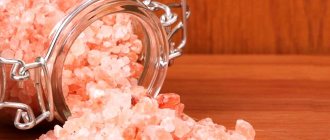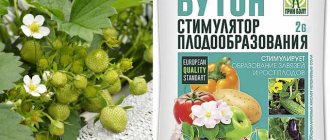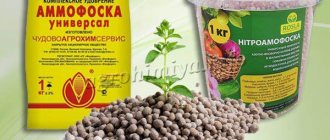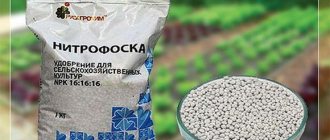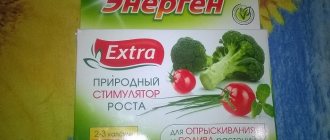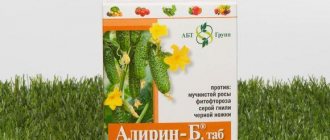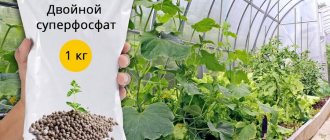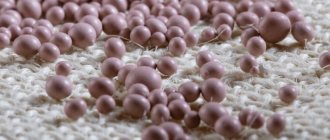By using the soil for many years and getting a lot of harvest from it, we deprive it of many useful elements that the soil receives when plants die. But we remove these plants from the site in order to prevent the appearance of pests and diseases. If the soil is left without these microelements, it will become poor, and double superphosphate can cope with this problem. But double superphosphate is also a good fertilizer; each crop has its own application dose. There are instructions for use that must be followed to get the maximum benefit from this feeding.
Specialist consultation
(24)2 x H2O – 2СаSO4 x 2Н2О calcium dihydrogen orthophosphate monohydrate. From the chemical formula, it follows that in addition to phosphorus, the substance includes calcium and sulfur. Unlike simple superphosphate, these additives are not ballast for the compound. Therefore, its action as a fertilizer is much more effective and economical.
Based on materials from the book by O. A. Petrosyan “Fertilizers and fertilizing. Useful tips"
Double superphosphate refers to nitrogen-phosphorus fertilizers
Phosphorus is the main active ingredient for which fertilizer is produced. Its percentage in the substance is 43-46%. In addition to it, nitrogen is present - and in small quantities:
- calcium sulfate
- monomagnesium phosphate,
- Sulfur, iron, aluminum and other trace elements.
It has the same effect on plants as simple superphosphate, but is used in a smaller volume.
Phosphorus-containing substances accompany plants, starting from planting and at all stages of vegetative development.
Double superphosphate is used:
- For the survival of all crops when planting. In this case, the fertilizer accelerates the regrowth of hair-like roots, which absorb nutrients from the soil. What determines plant rooting?
- In the ongoing care of established plants, phosphorus is responsible for the synthesis of chlorophyll and other pigments . Its deficiency is reflected in the color and size of leaves and flowers. To ensure the full development of the ground mass in the spring, phosphorus is removed during the budding period and after the growth of young stems and leaves.
- Without phosphorus, the formation of glucose, sucrose, starch, etc. in fruits is impossible . To form these complex compounds, fertilizer is applied after flowering and at the beginning of the formation and ripening of fruits.
- After harvesting, you need to take care of the fate of perennial and woody plants next year. In other words , strengthen plant tissues, especially the root system. To do this, phosphorus-containing fertilizers are added to the soil in the fall in combination with potassium salts. This prepares the plants for a safe winter.
Considering the multifaceted influence of the element on plants, it is worth taking a closer look at the features of using double superphosphate at different periods of plant growing.
The role of phosphorus in plant development: how to determine phosphorus deficiency
The role of phosphorus fertilizers for plants cannot be overestimated: thanks to this element, the root system of plants develops and strengthens, taste characteristics increase, fruiting increases and oxidative reactions in plant tissues decrease. When a plant is sufficiently provided with phosphorus, it uses moisture more economically, the amount of healthy sugars in the tissues increases, the tillering of plants increases, and flowering becomes more abundant and fruitful. With sufficient phosphorus, active fruiting, accelerated ripening, and high yield are ensured. Thanks to phosphorus, the resistance of plants to diseases and changes in weather conditions, as well as the taste of fruits, increases.
Phosphorus for plants is a stimulant; it encourages the plant to transition from the period of growth to flowering, then to fruiting, activating all the necessary life processes. Lack of phosphorus reduces protein synthesis processes and increases the level of nitrates in plant tissues. The lack of the required amount of the element slows down growth, the leafy mass of the plant changes color. With a lack of phosphorus, the plant becomes more susceptible to fungal and viral infections.
General recommendations for using fertilizer before planting and during further care
Double superphosphate contains phosphorus oxide in a water-soluble form. This is important when caring for plants, because it ensures full access of the nutrient to the tissue. It should be taken into account that the substance dissolves in water slowly. For example, nitrogen fertilizers combine with water better and act much faster.
It is better to apply double superphosphate in advance. For different purposes, fertilizer is used at different application rates. The most commonly recommended dosage is:
| Preliminary soil preparation in the fall for planting a vegetable garden in the spring of next year | · 40-50 g/m² on primary planting soils; · 55-70 g/m² – on cultivated lands with repeated crop rotation. |
| Planting trees and shrubs | In a planting hole of size: · 30 cm x 30 cm x 30 cm – 20 – 25 g; · 50 cm x 50 cm x 50 cm – 30 – 35 g; · 1 m x 1 m x 1 m – 40 – 50 g. |
| To improve flowering and fruiting of garden crops and fruit trees and shrubs | 40 – 70 g, depending on the size of the plant |
| With a lack of phosphorus in the soil | From 20 g/m² |
What is used to make the product?
Sources of phosphorus are natural ingredients, phosphorite, bones from animals. Phosphorite is treated with phosphoric acid before use. This sedimentary rock of the mountains is the main source of phosphorus. First, phosphoric acid is produced using phosphorites.
Extraction involves treating the resulting element with sulfuric acid at a certain concentration. The resulting composition is applied to phosphorites, then the substance is converted into granules, dried, and a benign product is obtained. Phosphorites are ground into small pieces.
The result of grinding is the production of phosphorus flour. Farmers use flour for agriculture. It is different from the concentrated product. Confusion of these means is fraught with consequences for people who do not have the information.
Technique for applying double superphosphate
For garden crops
Since fertilizers dissolve slowly in the soil, it is better to apply it in advance. To prepare the garden, it is better to do this in the fall. Over the winter, the powder (or granules) will dissolve as much as possible under the influence of soil moisture, and the bed will be ready for spring planting.
Application of superphosphate in autumn:
- The area where the vegetable garden is planned is cleared of all plant debris;
- Spread the fertilizer evenly over the entire area;
- Loosen to a depth of 5 - 10 cm. If you leave the granules on the surface, they will dissolve even more slowly and unevenly. As a result, the concentration of fertilizers may be spotty and in the future may harm the plants.
In spring, it is better to add 10 g of fertilizer to each hole when planting seedlings of tomatoes, cucumbers, eggplants, peppers, and cabbage. For potatoes, the norm is doubled.
When planting, the powder (or granules) must be thoroughly mixed with the soil and ensure that the fertilizer does not come into contact with the exposed root system of the seedlings or tubers.
If double superphosphate was not used in the fall, then in the spring it should be applied no later than 2 weeks before planting, preferably a month.
Tip # 1. To ensure that fertilizer brings as much benefit as possible, apply it as early as possible in the spring. The optimal period is determined by the condition of the soil after the snow melts, when the ground remains moist, but no longer wet, you can walk on it without your feet getting stuck.
When planting trees and shrubs
In order for woody plants to take root as best as possible, double superphosphate is mixed with the fertile mixture in which the plants are planted.
The sequence of planting trees and shrubs with the addition of double superphosphate is described in the table.
It is recommended to do this in the following sequence:
| Step 1. | When digging a hole, a fertile layer of soil 25 cm deep is laid on one side. The soil that lies deeper is placed in another pile, next to it. |
| Step 2. | Add the following fertilizer complex to the first pile: · Double superphosphate – 20 – 25 g; · Potassium chloride – 10 – 15 g; · Humus or compost – 1 bucket. Add the same to less fertile soil, only increase the amount by 1.5 times. |
| Step 3. | Mix the fertilizer evenly. |
| Step 4. | Lay the soil in the same order as it was before digging, first the bottom layer, and then the one on top. More fertile soil is located under the root system. |
Important! When planting trees, nitrogen fertilizers are never applied (see → types of nitrogen fertilizers, application). Also, ammonium nitrate, urea, and calcium-containing substances such as lime, chalk, dolomite, etc. are not used together with superphosphate. When interacting with them, substances are formed in the soil that are inaccessible to plants. In the best case, nothing will happen and the crops will not receive nutrition. Then it will be wasted time, financial costs and wasted labor. It’s worse if new compounds harm the plants, even to the point of their death.
Instructions for the use of double superphosphate for routine care of open ground plants
For garden crops
To fertilize garden crops, it is better to use fertilizers in dissolved form, then the substance will act much faster and more efficiently.
To prepare the base solution you will need:
- Double superphosphate - 20 spoons,
- Water – 3 l.
For better dissolution, the fertilizer is poured with boiling water:
- 500 g granules;
- ½ liter of boiling water.
As a result, a dispersed form is obtained. Its consistency is reminiscent of good high-fat cow's milk.
If the granules are poured with cold water, they will not dissolve completely. You can add an additional portion of water to the sediment remaining after filtration or place it in compost, but you should not simply throw it away. Find out → how to make compost yourself + recipes.
Another way to achieve complete dissolution is to add humate containing phytosporin to the water (see → how to use Fitosporin for plant protection).
Before use, the base solution is diluted with water in a ratio of 150 ml per 10 liters of water. To it add 500 g of wood ash (preferably from birch firewood), 200 ml of infusion of any humus. It is needed as a source of nitrogen; without it, phosphorus cannot be absorbed by plants.
This fertilizer is well suited for spring fertilization of rooted seedlings of many garden crops.
It is administered in the following doses:
| Name of culture | Root watering rate per plant |
| Tomato | 200 – 250 ml |
| Eggplant | 150 – 200 ml |
| Pepper | |
| Potato | 400 – 500 ml |
| Cabbage | 300 – 400 ml |
| Cucumber | 200 – 250 ml |
The norm of nutritious watering for seedlings of beets, carrots, turnips, radishes, celery is
1 liter per 1 m/n of each row.
The following feeding of tomatoes, eggplants, peppers, cucumbers and potatoes is repeated after flowering. The dosage is the same as for the first session.
Feeding fruit trees and berry bushes
In the spring, after the snow has melted and the soil has been cleared of plant residues, double superphosphate is added to each trunk circle of a tree or shrub in the following amount:
- for young trees up to 5 years – 20 – 30 g
- for mature trees in the fruiting stage – 40 – 60 g,
- for berry bushes – currants, gooseberries, yoshta – 20 – 30 g
- for raspberries – 30 – 40 g per 1 m2 of row.
Powder or granules are evenly distributed on the soil away from the tree trunk or bush shoots. It is best at the level where the crown ends.
The fertilizer is evenly mixed with moist soil to a shallow depth.
To prepare woody plants for winter, a mixture of fertilizers is added to each trunk circle:
- Double superphosphate – 20 – 60 g;
- Potassium chloride – 20 – 30 g (see → the use of potassium chloride as a fertilizer + reviews);
- Humus or compost – 0.5 – 1 kg (see → how to make humus with your own hands).
The quantity depends on the size of the tree or bush.
Preparation of the solution
To prepare the working solution, use 20 tbsp. spoons of fertilizer, three liters of water. Then 150 grams of working solution, 0.5 liters of wood ash, and 20 grams of nitrogen fertilizer are added to 10 liters of clean water. The resulting solution is used for feeding. The presence of nitrogen in the solution is mandatory. Without it, plants cannot absorb phosphorus.
Superphosphate fertilizers are used in early spring, when crops are growing vigorously. It is at this time that plants need nitrogen. Phosphorus is supplied to plants gradually, its effect extends even over years. Superphosphate extract is a long-acting microelement. This is how the extract works on all crops.
Another dissolution method is the use of biobacteria. The product is mixed with Humate or other phytosporin solutions, this mixture is dissolved in hot water, left for 24 hours with stirring. Apply the solution by feeding the roots of plant crops.
Fertilizer may not be dug into the soil in the fall. During the same period, you can scatter it over areas, observing the dosage.
Foliar feeding
It is carried out for better absorption of nutrients by plants, as well as when a deficiency of an element is detected. Crops indicate that there is not enough phosphorus in the soil with the following symptoms:
- The leaves become small, lose turgor (elasticity), and look like withered;
- The upper side of the leaf acquires a bluish tint, the lower part of the plate turns red;
- Often the leaves curl at the edges, dry out and fall off prematurely;
- One of the characteristic signs is redness of leaf petioles and stems. They take on a red cherry hue;
- When flower buds bloom, small flowers of pale color appear. They crumble quickly. The ovary does not form well, even if it is formed, most often it immediately crumbles.
Symptoms are associated with a lack of nitrogen, because without it phosphorus cannot be absorbed.
Foliar feeding is carried out with a low concentration solution.
To quickly revive plants, they are sprayed with a solution prepared for root watering. But, they dilute its saturation three times less. That is, the base solution will need 50 g per 10 liters of water.
Treat leaves and stems from all sides in the evening.
Category: “Questions and answers”
Question No. 1. How can you correct the situation if more superphosphate was added than required?
In this case, you should not water the crops, although for a week. If the weather is too hot, then it is better to arrange shading and maintain the temperature + 220 - +250.
Question No. 2. Is it possible to add double superphosphate and ash together?
It is possible, but you need to take into account that the application rate for each type of fertilizer is halved.
A serious mistake gardeners make when using double superphosphate
Use fertilizer on acidic soils without prior neutralization. If the soil pH is less than 5.5, then phosphorus-containing compounds become inaccessible to plants. To normalize the acid-base balance, calcium-containing substances are added:
- Lime,
- Chalk,
- Dolomite flour.
It is better to carry out neutralization in advance, for example, in the fall, and double superphosphate in the spring. These substances are not used at the same time, because by reacting with each other they cause harm to plants.
How to calculate the dosage if you don’t have a scale at hand?
Double superphosphate is a fertilizer that requires strict adherence to dosage. But you don’t always have scales at hand. There are little tricks for this:
- a matchbox holds 27 g of the substance;
- a faceted glass can hold up to 210 g of substance;
- a teaspoon is 7 g of double superphosphate;
- heaped tablespoon - 27 g of substance.
Despite the fact that using a matchbox you can quite accurately calculate the amount of granulate or powder, it is still better to have an electronic kitchen scale on hand. The accuracy of the dosage of the substance for feeding seedlings is especially important.
